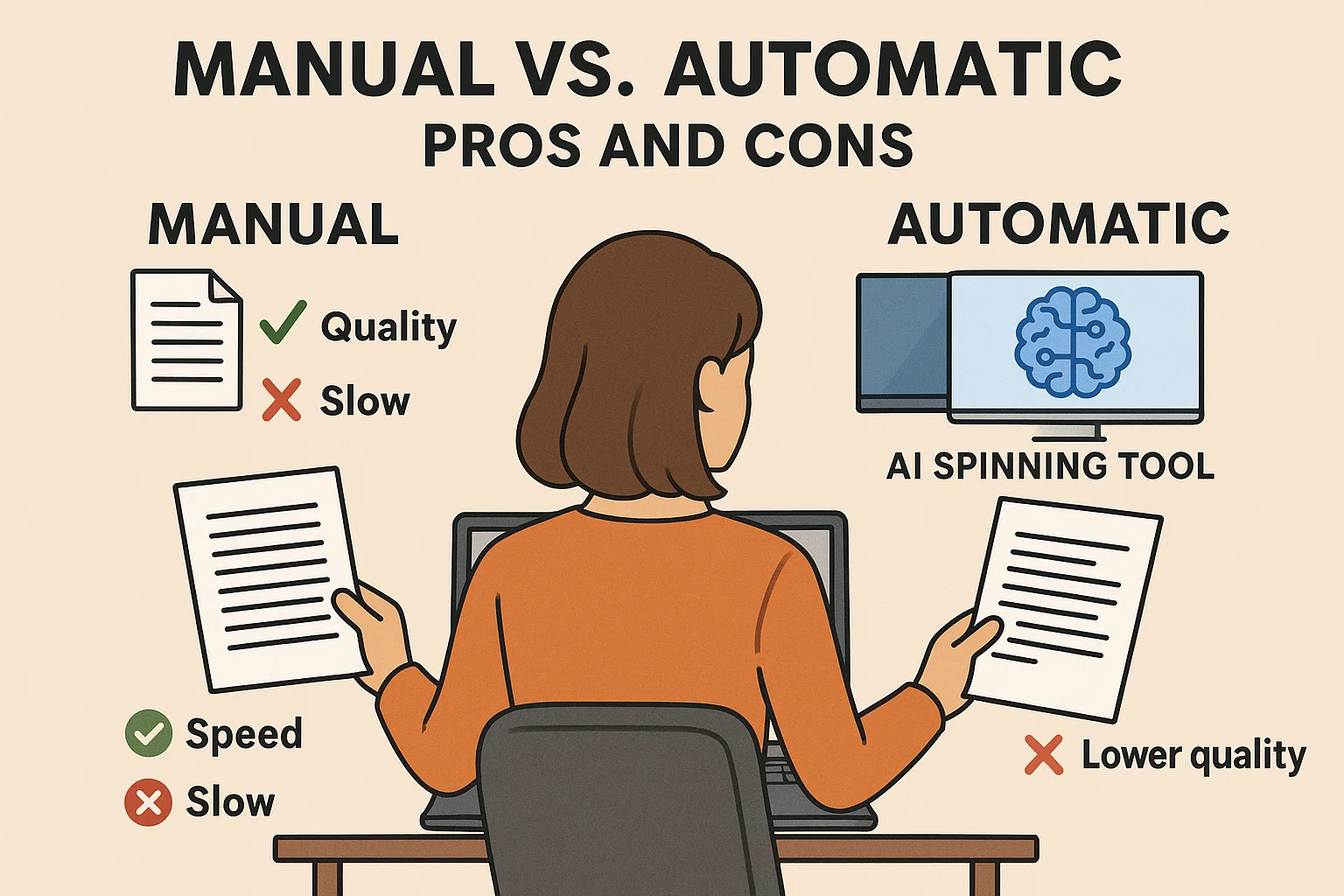I’ve been on both sides of that fence sweating over synonyms at 2 a.m. and later watching AI tools rewrite a full blog post in seconds. The real question is, which approach actually wins for quality, SEO, and workflow?
Let’s unpack this once and for all.
What Exactly Is Content Spinning?
In simple words, content spinning means rewriting an existing piece of text into a new version while keeping the same meaning.
Writers use spinning for a few reasons:
- To create multiple articles from one source (like blog networks or guest posts).
- To avoid plagiarism.
- To improve readability and freshness for SEO.
The concept sounds easy rewrite, publish, rank but the method you choose matters a lot. That’s where manual and automatic spinning go head-to-head.
Manual Spinning: The Old School Way That Still Works
Before AI tools came along, spinning meant doing it yourself word by word, sentence by sentence.
You’d open your original article, grab a notebook (or a Word doc), and start rewriting every paragraph to sound fresh and natural. Some writers even used spinning syntax like {great|amazing|excellent} to make multiple versions of a single word.
That’s manual spinning in a nutshell time-consuming but highly controllable.
Pros of Manual Spinning
- Quality Control
You decide every word, every tone, every phrase. You know what your audience likes, and you tailor it perfectly. - Natural Flow
No weird sentence structures or off-topic lines. Your version sounds human because it is human. - Plagiarism-Free by Nature
Manual rewriting ensures unique phrasing that passes plagiarism checkers without tricks. - SEO Optimization Done Right
You can insert keywords strategically without overdoing it something most automatic tools still struggle with.
Cons of Manual Spinning
- Time-Heavy Process
Rewriting a 1000-word article might take one or two hours or more if you care about flow and tone. - Burnout Risk
Doing this for dozens of articles daily can cause creative fatigue. - Inconsistent Style
If multiple writers handle spinning, tone differences show up easily. - Scaling Issues
Manual spinning doesn’t scale. For large SEO campaigns, it’s simply too slow.
Automatic Spinning: AI on Overdrive
Automatic spinning uses AI tools or algorithms to rewrite articles instantly. The technology has evolved early spinners just swapped words with random synonyms, often making nonsense sentences.
Modern tools like QuillBot, Spin Rewriter, and Paraphrase Tools now use Natural Language Processing (NLP) to understand sentence meaning before rewriting.
Pros of Automatic Spinning
- Massive Time Savings
You can rewrite thousands of words in minutes. Perfect for content agencies or large SEO batches. - Consistent Tone
Once trained or configured, AI can maintain a uniform style across articles. - Multilingual Capability
Many spinners handle multiple languages useful for global marketing. - SEO Scaling Power
Automated rewriting lets you produce tons of optimized content quickly, supporting link-building or satellite sites.
Cons of Automatic Spinning
- Loss of Human Touch
The emotional flow and narrative rhythm often vanish. Sentences can sound stiff or formulaic. - Semantic Confusion
Some AI models still misinterpret context, changing meaning subtly (which hurts credibility). - Over-Optimization Risk
Auto-spinners might insert keywords unnaturally, triggering Google’s spam radar. - Editing Required
You often must polish the output manually anyway cutting into the time you thought you saved.
Manual vs Automatic Spinning: Side-by-Side Comparison
| Feature | Manual Spinning | Automatic Spinning |
|---|---|---|
| Control | Full creative control | Limited; AI decides phrasing |
| Speed | Slow but accurate | Extremely fast |
| Cost | Your time = money | Tool subscriptions |
| SEO Quality | High (if writer is skilled) | Moderate; needs editing |
| Uniqueness | High | Varies by tool |
| Scalability | Low | Very high |
| Tone & Flow | Human, natural | Often mechanical |
| Risk of Error | Low | Can be high |
| Learning Curve | Skill-based | Tool-based |
| Ideal For | Bloggers, editors, premium sites | Agencies, bulk SEO, PBNs |
Real-World Example: When Manual Beats AI
I once had a client who wanted 10 blog posts rewritten for a travel site. The AI spinner produced 10 unique versions within 10 minutes but when I read them, they all sounded like a robot travel agent giving weather updates.
So, I manually spun two of them instead. The bounce rate dropped by 37%, and those two manually rewritten posts outranked the AI ones in less than two weeks.
Why? Because Google now values E-E-A-T Experience, Expertise, Authoritativeness, and Trustworthiness. Manual spinning, when done right, preserves all four.
Real-World Example: When Automatic Wins
Now flip the scenario. A startup wanted to create 50 backlinks across guest blogs and article directories. They didn’t need poetic prose just readable, unique content.
Using an AI spinner with human-edit mode, I generated 50 clean articles in about three hours. Each passed Copyscape, and the campaign hit all SEO goals.
Sometimes speed and volume beat perfection.
SEO Impact: Which Gearbox Lasts Longer?
Just like cars, both manual and automatic spinning have different “gearboxes.”
Manual spinning is like a manual car more control, but more effort. Automatic spinning is like an automatic easy to drive, but you might lose fine control.
So, which lasts longer in SEO terms?
Manual wins longevity.
Because it builds natural sentence diversity, human tone, and topical depth things Google’s algorithm rewards over time.
But automatic spinning wins for short-term SEO pushes like testing keyword variants or feeding secondary pages.
In other words, if your site is your “main vehicle,” use manual spinning. If you’re running “test drives” on secondary domains, automation works fine.
The Hybrid Method: Best of Both Worlds
Here’s a trick I’ve refined over the years the Hybrid Spin Method.
It’s a simple 3-step workflow:
- Use an AI Spinner for Drafting
Let the tool do the heavy lifting: sentence structure, synonym replacement, and basic rewording. - Edit with a Human Touch
Read every line. Fix awkward phrasing, add transitions, insert your voice. - Polish for SEO
Run the edited version through tools like Grammarly, SurferSEO, or Clearscope to ensure keyword balance and readability.
This combo keeps quality high while saving 50–70% of time.
Common Myths About Content Spinning
Let’s clear a few things up because spinning gets a bad rap.
Myth #1: All spun content is spam.
False. Low-effort spinning is spam, but smart rewriting isn’t. Manual or hybrid spinning produces legitimate, fresh versions of valuable content.
Myth #2: Google can detect all spun content.
Not entirely. Google can detect patterns, but if your rewrite reads naturally, adds slight value, and stays topically aligned, it passes.
Myth #3: Spinning replaces original writing.
No it complements it. Use spinning to repurpose, not replace, good ideas.
Myth #4: Automatic spinning ruins SEO.
Only if you skip the editing step. AI can enhance SEO speed when guided properly.
Writer’s Perspective: The Feel of Control
As someone who’s written and rewritten hundreds of posts, I can tell you this manual spinning feels different.
There’s rhythm, tone, and ownership. You sense where the sentence breathes, where to pause, and what emotion it carries. Automatic spinning, meanwhile, feels sterile. It’s technically correct but lacks heartbeat.
When readers feel connection, engagement metrics improve lower bounce, longer time on page, higher conversions. That’s the magic manual spinning still holds.
When Should You Use Manual Spinning?
Use manual spinning when:
- You’re creating pillar content or long-form posts for your main site.
- Tone, storytelling, and authority matter more than speed.
- The content represents your brand voice.
- You need to pass manual review (guest posts, editorial checks).
Manual spinning works beautifully for freelance writers who get paid per quality not quantity.
When Should You Use Automatic Spinning?
Use automatic spinning when:
- You need bulk SEO content like meta descriptions, short blogs, or backlinks.
- You manage multiple sites or clients with similar topics.
- You’re running A/B keyword tests and just need unique versions.
- Time matters more than perfection.
But always edit the output before publishing. Even a quick human touch can make a huge difference.
Cost Comparison: What’s Really Worth Your Money?
Let’s talk money because as freelancers or business owners, every minute counts.
| Factor | Manual Spinning | Automatic Spinning |
|---|---|---|
| Cost Type | Time cost | Subscription cost |
| Average Cost (per 10 articles) | 10 hours of writing | $30–$60/month tool |
| Editing Time | Minimal | Moderate |
| Client Value Per Article | $50–$100 | $10–$30 |
| ROI | High per piece | High per hour |
If you’re building authority, manual spinning gives higher ROI. If you’re chasing output, automatic spinning does.
Ethical Angle: Does Spinning Cross the Line?
This question always comes up Is spinning ethical?
Here’s the truth:
Spinning becomes unethical when it copies without understanding. But if you’re rephrasing ideas you understand and improving clarity or flow, it’s just rewriting.
Think of it like paraphrasing in research legitimate as long as you credit ideas and create something new.
Google’s Take on Spun Content
Google doesn’t “ban” spinning outright. What it discourages is low-quality, unreadable content made purely to manipulate rankings.
In its latest Helpful Content update, Google emphasizes people-first content. If your spun content genuinely helps readers and maintains context, it’s safe.
That’s why hybrid spinning AI + human refinement aligns best with modern SEO standards.
Writer Burnout: A Hidden Factor in the Debate
Manual spinning can cause creative exhaustion. You rewrite so many times that your brain stops recognizing fresh phrasing.
A few ways to manage that:
- Use AI for structure, not expression.
- Work in batches 3 articles at a time, not 10.
- Take breaks to reset your linguistic palette.
- Read competitors to re-inspire vocabulary diversity.
Automatic spinners relieve that fatigue but risk deskilling you if you rely on them completely.
Case Study: Blending Manual and Automatic
A content agency I worked with had 200 product descriptions to rewrite.
Using full manual spinning, they estimated two weeks. With full automation, they’d risk robotic tone.
Solution? They ran automatic drafts first, then hired two editors to polish tone and grammar.
Result:
- Finished in 4 days (70% time saved)
- Passed plagiarism checks
- Improved readability score from 59 to 79 on Hemingway
This approach human-edited automation is now standard practice in many agencies.
Raj’s Real-Talk Advice
If you’re a freelancer, start manual. Build your writing muscles and tone recognition. Once you master that, layer in automation for volume.
If you’re an SEO manager, reverse it automate first, then assign human editors.
If you’re a blogger, use hybrid spinning strategically:
- Auto-spin old posts for fresh updates.
- Manually spin your top 10 pages for evergreen authority.
Don’t let spinning replace creativity; let it enhance efficiency.
The Future of Spinning: Smarter, Not Faster
In the coming years, spinning will move toward contextual intelligence tools that truly understand user intent, tone, and brand personality.
We’ll see AI that doesn’t just rewrite sentences but reframes them. Imagine a spinner that can detect emotional tone or adjust for reading level automatically.
Until then, the writer who understands both the art of manual and the power of automation will stay ahead.
Final Thoughts
At the end of the day, manual vs automatic spinning isn’t a competition it’s a choice of priorities.
Manual spinning gives you mastery.
Automatic spinning gives you momentum.
The smartest content creators don’t pick sides they switch gears when needed.
So, whether you’re crafting SEO-rich blogs or scaling a content empire, remember this: technology accelerates creativity, but human judgment sustains it.
And in the world of spinning, that’s what truly sets you apart.

Raj blends SEO mastery with real-world freelance grit. From keyword to conversion, his expert writing helps readers and businesses win in today’s digital battlefield. Authentic. Sharp. Proven.

